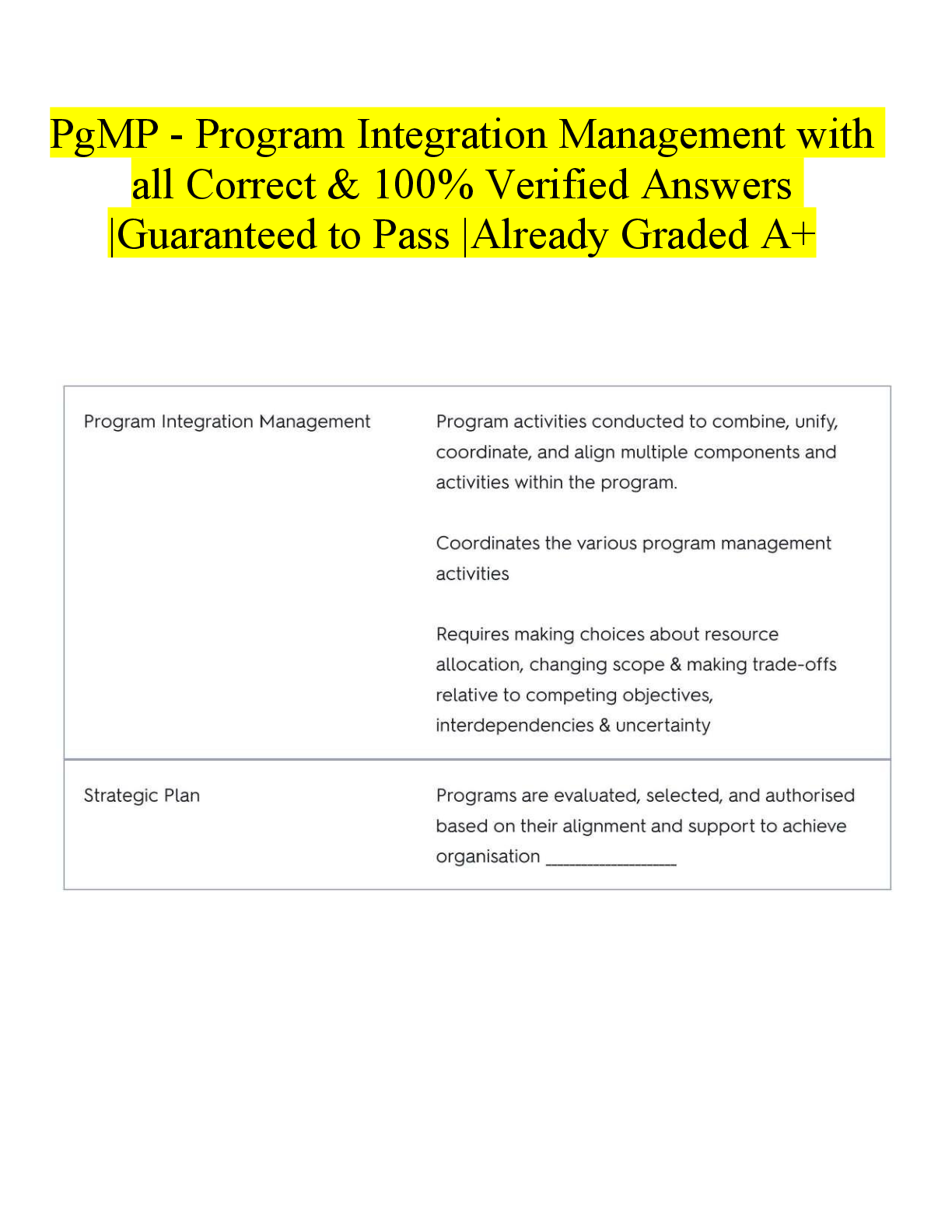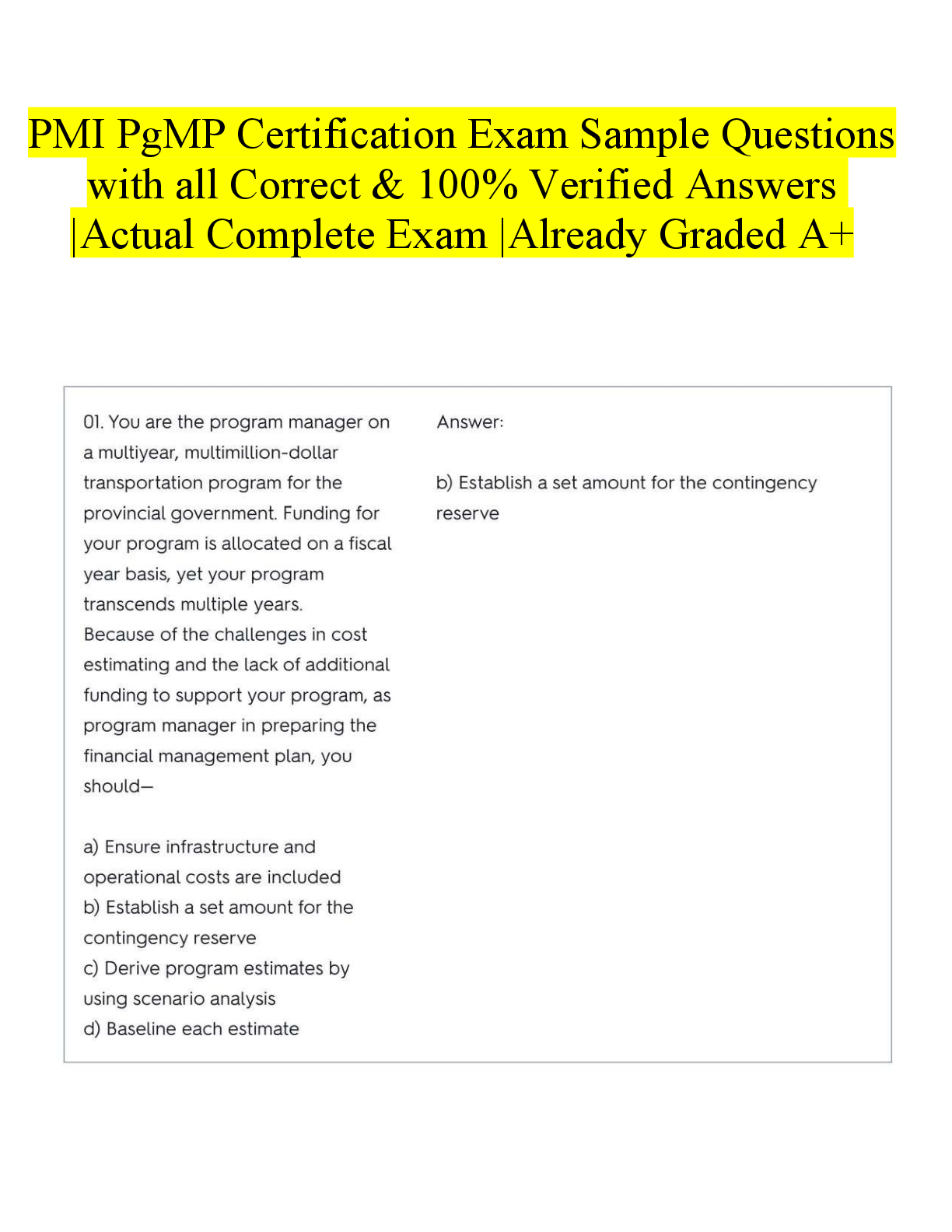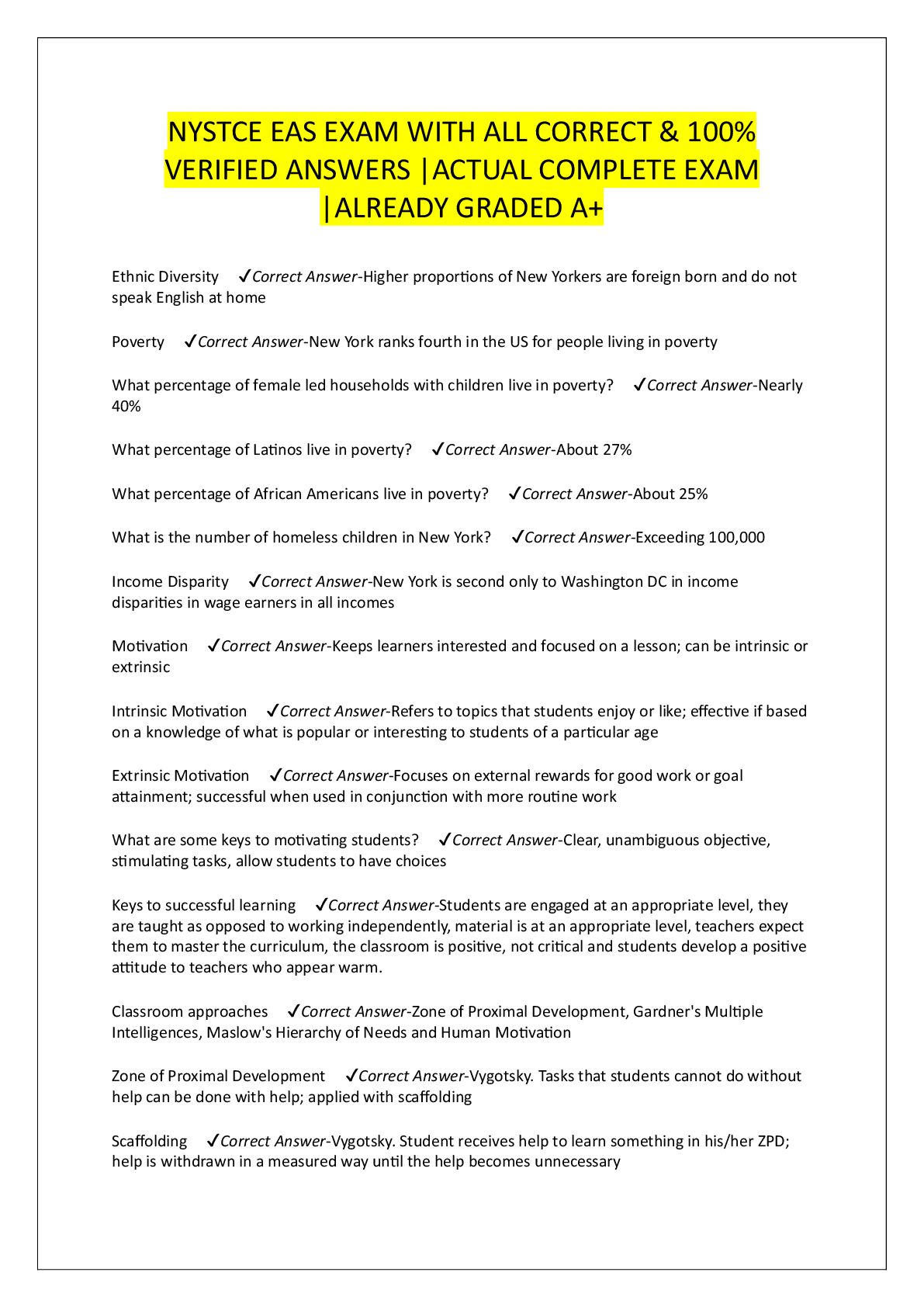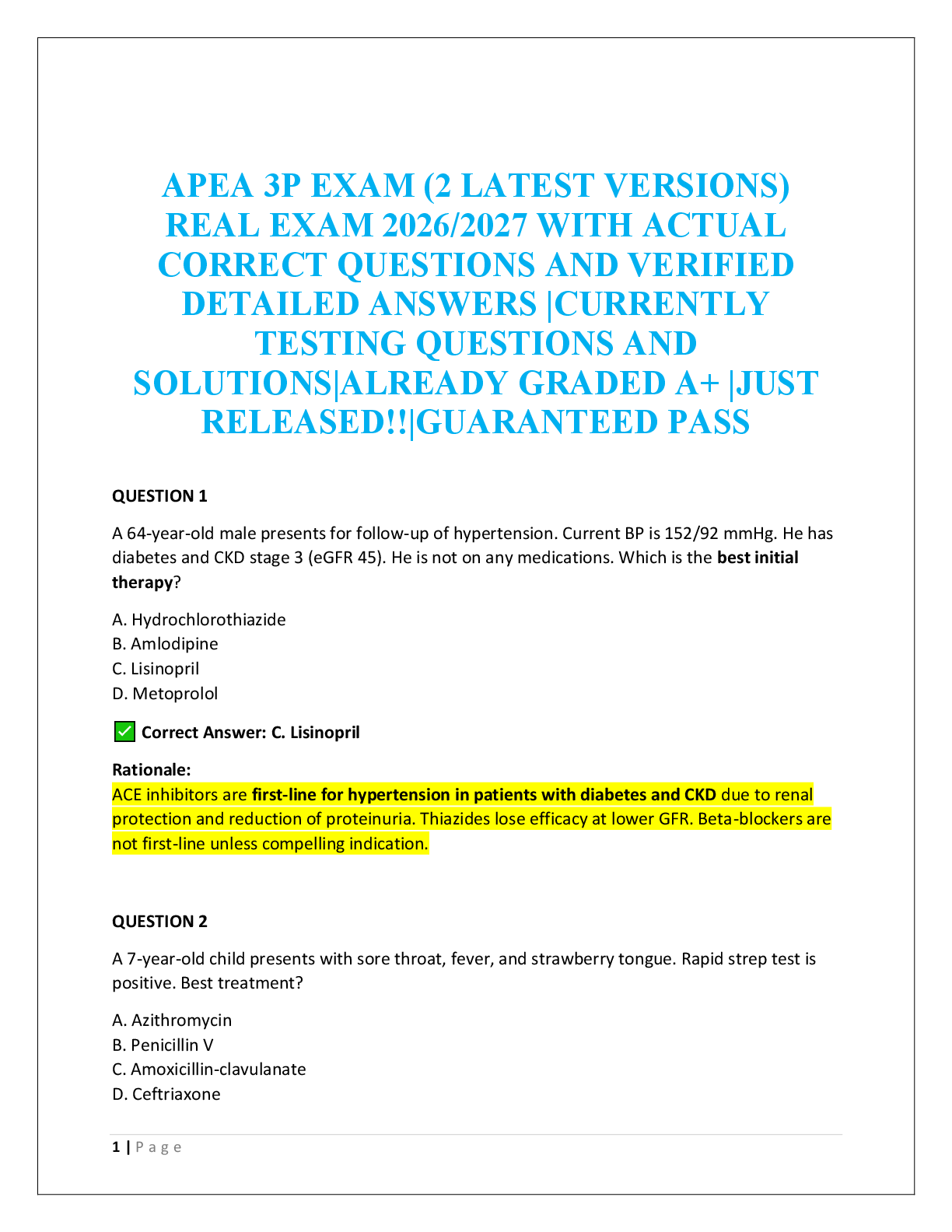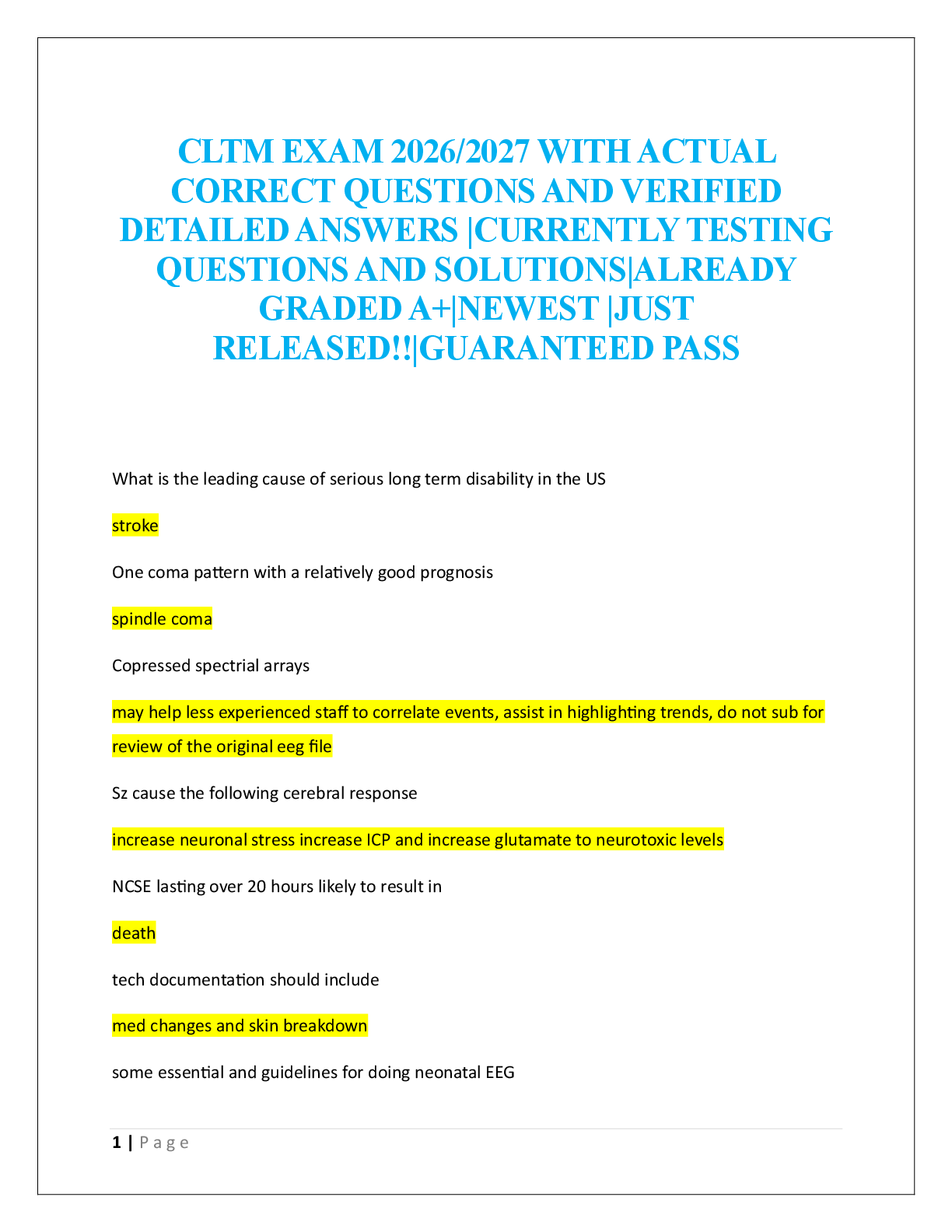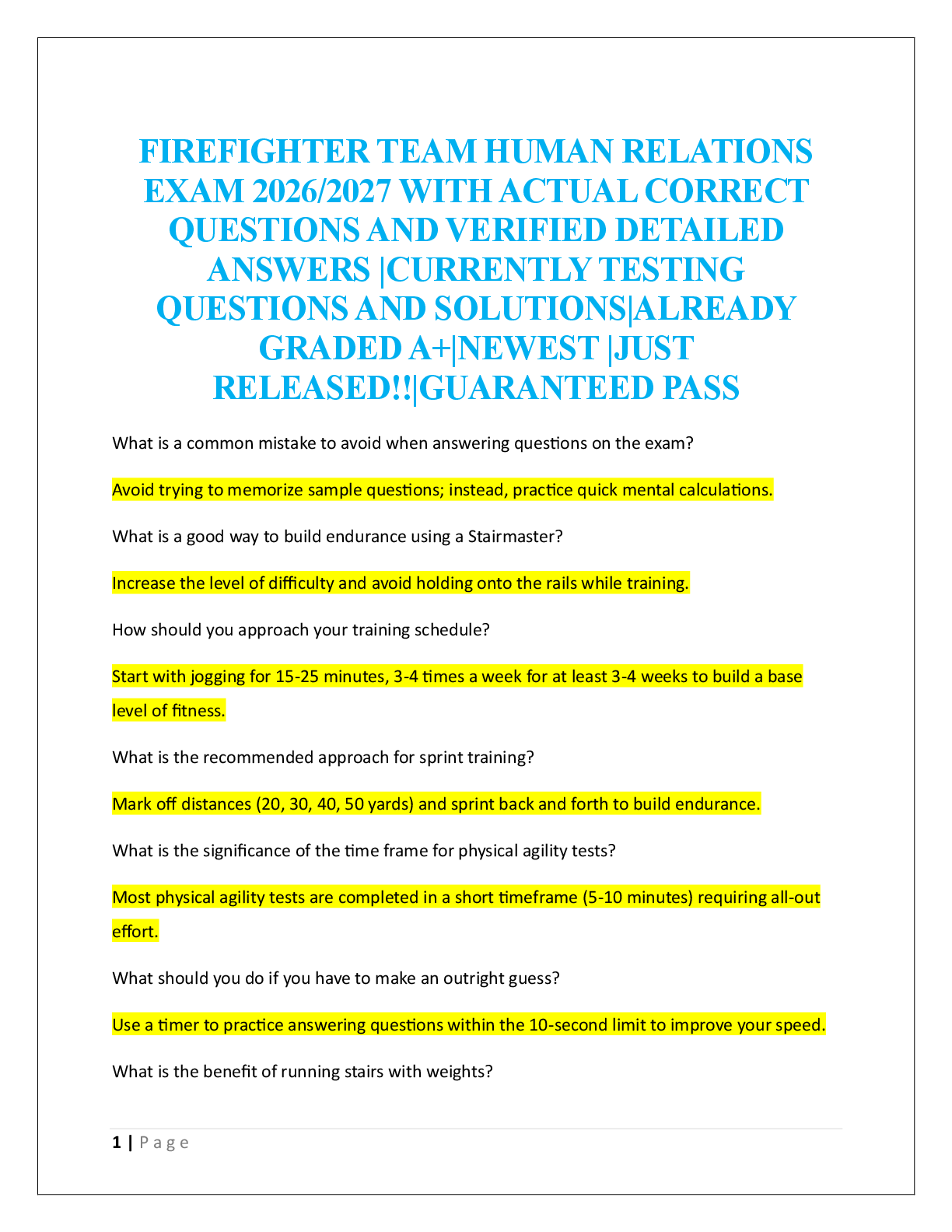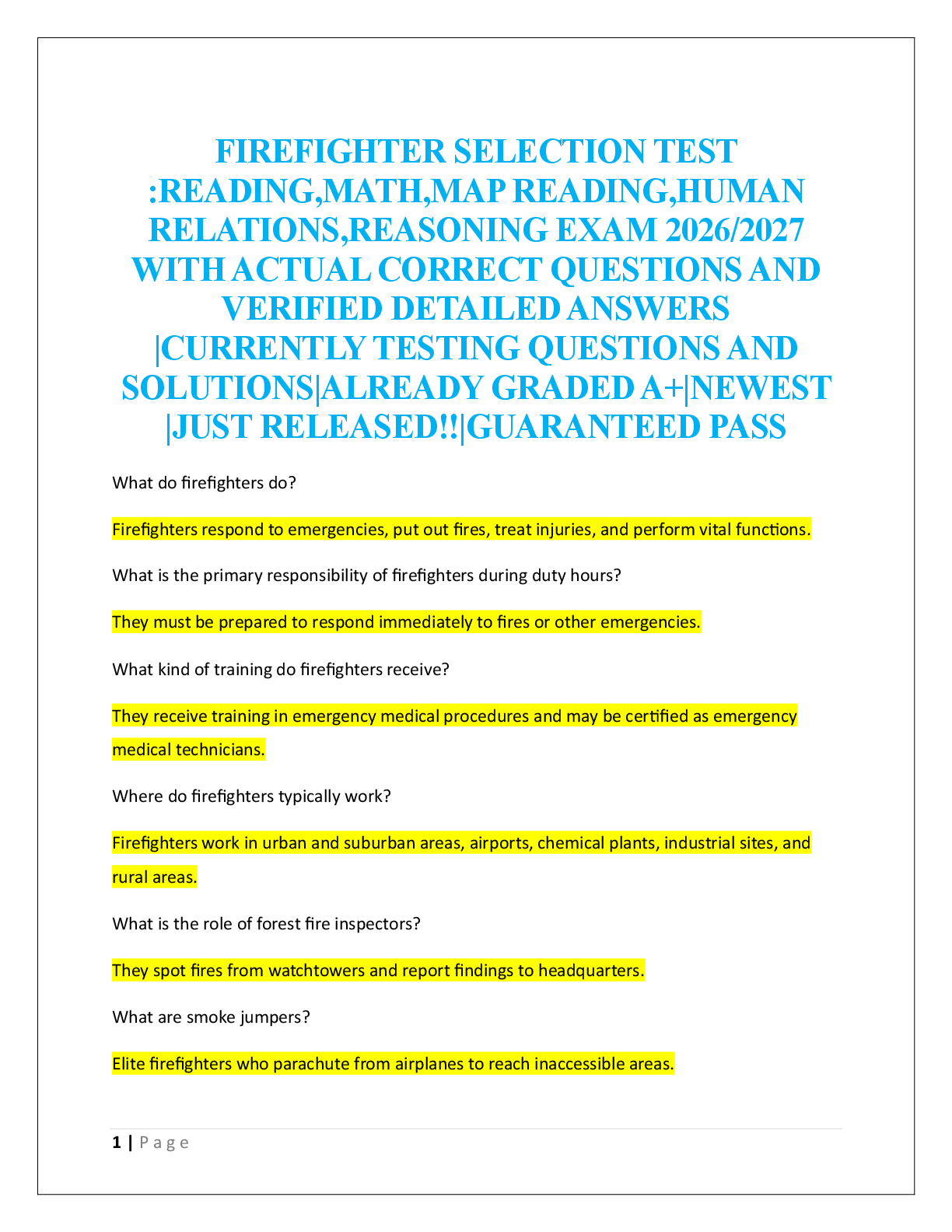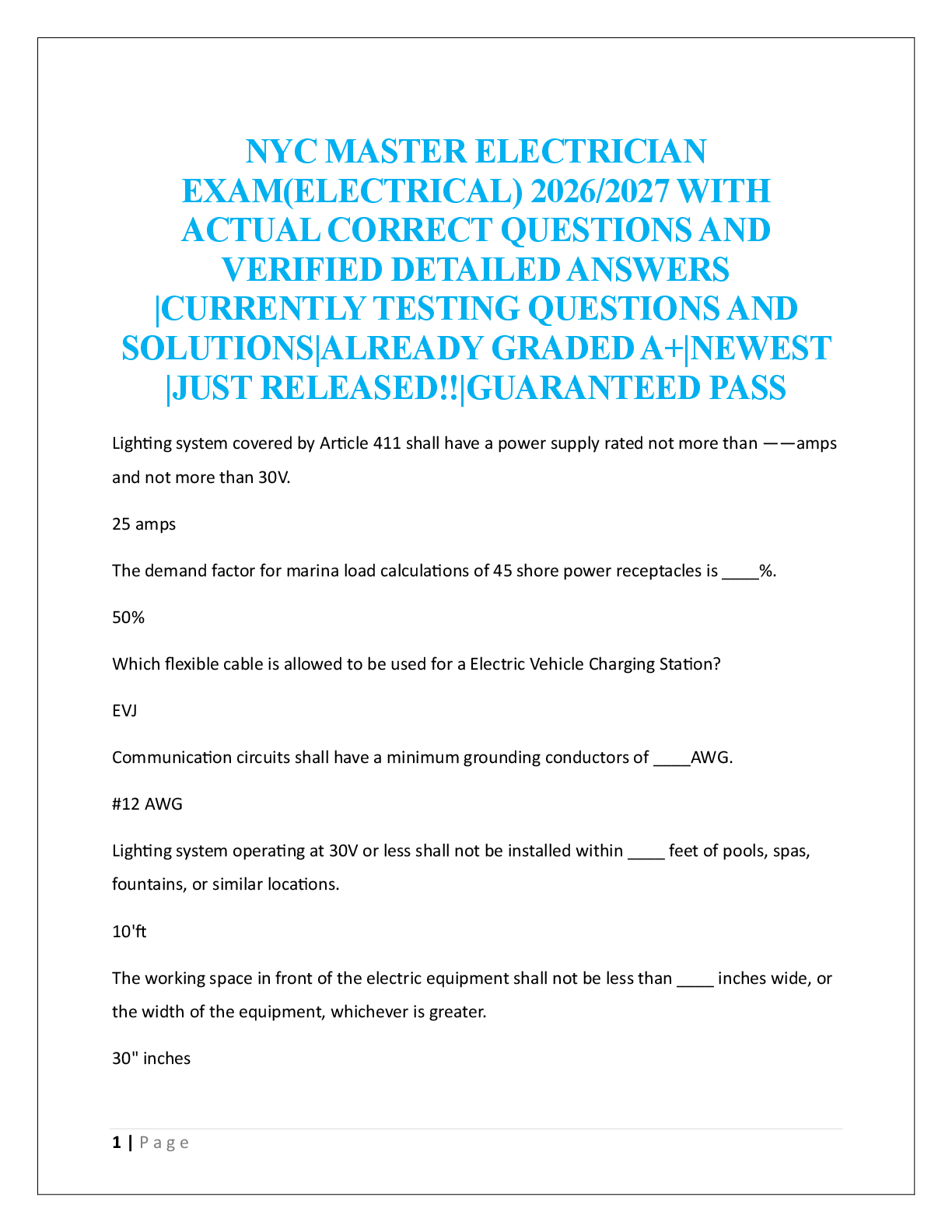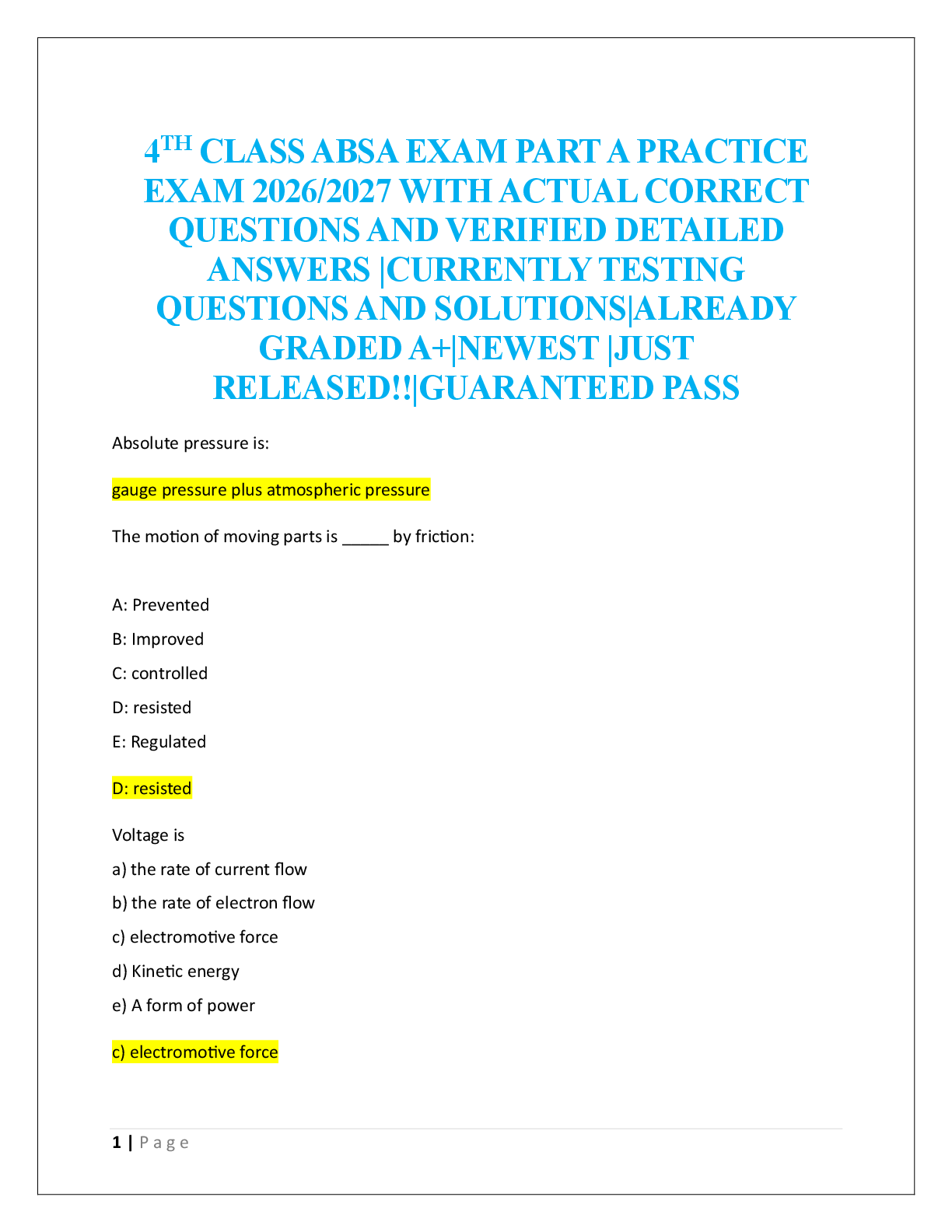*NURSING > EXAM > NR-507 Final Study Guide possible questions a-z – Chamberlain College | NR507 Final Study Guide po (All)
NR-507 Final Study Guide possible questions a-z – Chamberlain College | NR507 Final Study Guide possible questions a-z
Document Content and Description Below
NR-507 Final Study Guide possible questions a-z – Chamberlain College 1. Acid base imbalance ¬ While checking arterial blood gas results, a nurse finds respiratory acidosis. What does the nu ... rse suspect is occurring in the patient? reduced tidal volumes ¬ A 20-year-old male is in acute pain. An arterial blood gas reveals decreased carbon dioxide (CO2 ) levels. Which of the following does the nurse suspect is the most likely cause? Hyperventilation ¬ The nurse is assessing a client with suspected respiratory acidosis. Which assessment items are priority for the nurse to collect? Rate and depth of respirations, Skin color and temperature, Appearance of the optic nerve o The nurse is administering sodium bicarbonate to the client with respiratory acidosis. The nurse understands that which is the primary goal of treatment for this client? Removing excess acids in blood ¬ The student nurse is assisting in the care for a client with acute respiratory acidosis. The nurse explains to the student nurse that the client's blood pH initially falls in the development of acute respiratory acidosis because of which process? Hypoventilation 2. ACTH ¬ The nurse is preparing a client for testing to determine if the client has Cushing syndrome. What tests are included in the screening process 24-hour urine secretion of cortisol Dexamethasone suppression test Plasma levels of ACTH ¬ A client comes to the clinic with fatigue and muscle weakness. The client also states she has been having diarrhea. The nurse observes the skin of the client has a bronze tone and when asked, the client says she has not had any sun exposure. The mucous membranes of the gums are bluish-black. When reviewing laboratory results from this client, what does the nurse anticipate seeing? Increased levels of ACTH ¬ A client is diagnosed with adrenocorticotropic hormone deficiency (ACTH) and is to begin replacement therapy. Regarding which type of replacement will the nurse educate the client? Cortisol replacement therapy ¬ Following destruction of the pituitary gland, ACTH stimulation stops. Without ACTH to stimulate the adrenal glands, the adrenals' production of cortisol drops. This is an example of which type of endocrine disorder? Secondary ¬ The nurse is preparing a client for a test that will measure negative feedback suppression of ACTH. Which medication will the nurse administer in conjunction for this test? Dexamethasone ¬ ACTH deficiency results in secondary hypocortisolism ¬ ACTH deficiency is most commonly caused by? glucocorticoid withdrawal ¬ 6 symptoms of an ACTH deficiency tiredness weakness anorexia N/V hypoglycemia orthostatic hypotension ¬ interpretation of ACTH levels requires simultaneous assessment of plasma cortisol levels ¬ ACTH levels are normal to high in primary adrenal insufficiency ¬ ACTH levels are low to absent in secondary adrenal insufficiency ¬ The client has been taking an oral cortisol preparation for 2 years to manage an autoimmune disease. What effects does the nurse expect this therapy to have on this client's circulating levels of ACTH and aldosterone? Decreased ACTH, decreased aldosterone ¬ A nurse checks lab results as both Cushing syndrome and Addison disease can manifest with elevated levels of: Adrenocorticotropic hormone (ACTH) 3. Acute epiglottitis ¬ A caregiver calls the pediatrician's office and reports to the nurse that her 4-year-old, who was fine the previous day, complained of a sore throat early in the morning and now has a temperature of 102.6° F (39.2° C). The caregiver has tried to get the child to nap but the child gets panicky, immediately sits back up, and leans forward with her mouth open and tongue out when the caregiver encourages her to lie down. The nurse suspects the child has which of the following conditions? Epiglottitis ¬ The caregivers of a child report that their child had a cold and complained of a sore throat. When interviewed further they report that the child has a high fever, is very anxious, and is breathing by sitting up and leaning forward with the mouth open and the tongue out. The nurse recognizes these symptoms as those seen with which of the following disorders? Epiglottitis ¬ The nurse is caring for a 5-year-old girl who shows signs and symptoms of epiglottitis. The nurse recognizes a common complication of the disorder is for the child to: be at risk for respiratory distress. ¬ A 5-year-old child is brought to the clinic by his father because the child developed a high fever over the past 2 to 3 hours. The nurse suspects epiglottitis based on which signs and symptoms? • Difficulty speaking • Drooling • Sitting with neck extended • Frightened appearance 4. AIDS ¬ A 36-year-old man enters the hospital in an extremely debilitated condition. He has purple-brown skin lesions (a symptom of Kaposi's sarcoma) and a persistent cough. A physical examination reveals swollen lymph nodes, and laboratory tests find a very low lymphocyte count. Information taken during the personal history reveals that he has multiple sex partners with whom he frequently engages in unprotected sex. What is likely to be the man's problem and what is his prognosis? He is probably suffering from AIDS. His outlook is poor once the disease has progressed to this advanced stage. There is no cure, and drug therapy has had limited short-term success. ¬ Why does nursing care of a patient with acquired immune deficiency syndrome (AIDS) include monitoring of T lymphocyte counts? A decrease in the number of T cells would make the patient more susceptible to infection and unusual cancers. ¬ What is the length of time from infection with the AIDS virus to seroconversion? Up to six months ¬ A 21-year-old woman diagnosed with HIV/AIDS 4 years ago now presents with cytomegalovirus. The nurse explains to the woman that the infection is caused by a common organism that normally does not cause infection in someone with a healthy immune system. This type of infection is called what? Opportunistic infection ¬ The nurse is caring for a client who has just been diagnosed with AIDS. The client asks the nurse, "How long will I live?" Which of the following is an appropriate response by the nurse? "AIDS is considered to be a chronic illness today." ¬ Which of the following clients is at the greatest risk for developing an intracellular pathogen infection? An AIDS client with a decreased CD4+ TH1 count 5. Alveolar ventilation/perfusion ¬ A consequence of alveolar hypoxia is: Pulmonary artery vasoconstriction ¬ The pressure required to inflate an alveolus is inversely related to: Alveolus radius ¬ The nurse is describing the movement of blood into and out of the capillary beds of the lungs to the body organs and tissues. What term should the nurse use to describe this process? Perfusion ¬ A pulmonologist is discussing the base of the lungs with staff. Which information should be included? At the base of the lungs: Arterial perfusion pressure exceeds alveolar gas pressure When the pulmonologist discusses the condition in which a series of alveoli in the left lower lo ¬ be receive adequate ventilation but do not have adequate perfusion, which statement indicates the nurse understands this condition? When this occurs in a patient it is called: Alveolar dead space ¬ Which of the following conditions should the nurse monitor for in a patient with hypoventilation? hypercapnia ¬ A nurse is describing the pathophysiology of emphysema. Which information should the nurse include? Emphysema results in: the destruction of alveolar septa and air trapping. 6. Alzheimer’s disease ¬ A patient is admitted to the unit in the middle stages of Alzheimer's disease. How would the nurse expect to find the patient's state of mind? Unable to perform simple tasks ¬ When teaching the children of a patient who is being evaluated for Alzheimer's disease (AD) about the disorder, the nurse explains that a diagnosis of AD can be made only when other causes of dementia have been ruled out. ¬ The patient has been diagnosed with the mild cognitive impairment stage of Alzheimer's disease. What nursing interventions should the nurse expect to use with this patient? Use a calendar and family pictures as memory aids. ¬ A patient with Alzheimer's disease (AD) dementia has manifestations of depression. The nurse knows that treatment of the patient with antidepressants will most likely do what? Improve cognitive function ¬ The wife of a patient who is manifesting deterioration in memory asks the nurse whether her husband has AD. The nurse explains that a diagnosis of AD is usually made when what happens? All other possible causes of dementia have been eliminated 7. Angiotensin-renin system ¬ The nurse recognizes that the action of angiotensin II is what? Vasoconstriction ¬ The nurse understands that aldosterone secretion is increased when the patient has what? Hyperkalemia ¬ With what does the nurse correlate the release of renin? Decreased renal perfusion ¬ What are the 2 most common causes that activate the RAAS system? Low cardiac output or low renal perfusion ¬ The goal of the RAAS system is to increase BP to thus help restore perfusion pressure to the kidneys 8. Antibodies, IgG, IgA, etc ¬ A patient has a parasite. Which lab report should the nurse check to help confirm this diagnosis? IgE ¬ If a patient has a typical secondary immune response, which antibody is most predominant? IgG. ¬ A mother is breastfeeding her infant. The nurse realizes the main antibody being transferred from the mother to her infant through the breast milk is: IgA ¬ When a person has a life-threatening hypersensitivity/allergic reaction to bee stings, which lab result will the nurse check IgE ¬ Which immunity principle should guide the nurse when caring for an infant? At birth, IgG levels in newborn infants are: near adult levels. ¬ While reviewing a patients' immunological profile, which immunoglobulin does the nurse expect to see elevated if the patient has a type I hypersensitivity reaction? IgE ¬ The antibody that becomes bound to mast cells and basophils and causes the cells to release histamine and other chemicals is IgE ¬ In teaching a patient with SLE about the disorder, the nurse knows that the pathophysiology of SLE includes the production of a variety of autoantibodies directed against components of the cell nucleus ¬ A patient is diagnosed with a hypersensitivity reaction mediated by immunoglobulin E (IgE) antibodies. For which type of hypersensitivity reaction should the nurse plan care for this patient? Type 12 9. Autosomal dominant diseases ¬ A nurse is assessing a patient with an autosomal-dominant inherited condition. When discussing the risk of transmission to the patient's offspring, which of the following would the nurse include? Each child has a 50% risk of inheriting the gene. ¬ A client has an autosomal-dominant disorder. His wife is unaffected. When explaining the risk for inheritance of the disorder in their offspring, which statement by the nurse would be most appropriate? There is a 50% chance that each of your children will have the condition ¬ The daughter of a patient with Huntington disease has requested that she be tested for the disease even though she has no symptoms at this time. What type of test does the nurse anticipate the physician will order? Presymptomatic testing ¬ Which of the following risk factors have been linked to ovarian cancers? Select all that apply. Gene mutations BRCA-1 and BRCA-2, Nulliparity ¬ A late acting dominant disorder is: Huntington's chorea ¬ Huntignton's chorea is characterised by Disordered muscle movement and mental disorientation ¬ Dancing gait and bizarre grimacing are characteristics of: Huntignton's disease ¬ The RN is reading the chart of a new pt. at the genetic clinic. The chart notes that the pt., her brother, and her mother all have inherited a particular condition. The RN plans care for a condition with which of the following type of inheritance pattern? autosomal dominant 10. Bartholin glands ¬ A woman visits her primary care provider with a complaint of pain and swelling in the vagina area. The pain is present when she sits and walks intercourse is painful. The nurse prepares the patient for an examination. The nurse and health care provider suspect that the patient may have an inflammation or infection of the? Bartholin glands ¬ A patient has been diagnosed with a Bartholin gland cyst. The nurse expects the patient may experience which symptoms if this becomes infected? Pain, tenderness, and dyspareunia ¬ The female external genitalia are made up of several components. What is in the vestibule of the female external genitalia? Bartholin glands ¬ When performing a pelvic examination, the nurse observes a red swollen area on the right side of the vaginal orifice. The nurse would document this as enlargement of which of the following? Bartholin's gland 11. Bile salt deficiencies ¬ Clinical manifestations of bile salt deficiencies are related to poor absorption of: Fats and fat-soluble vitamins 12. Candidiasis exacerbation ¬ Samantha Velasquez, a 24-year-old preschool teacher, is being seen by the physician in the primary care group where you practice nursing. Over the past 2 months, she has been receiving treatment for multiple ear infections and tonsillitis. She reports a curdy white vaginal discharge and burning with urination. What is the most likely cause of her symptoms? Candida albicans ¬ A nurse is counseling a client about risk factors for yeast infections. Which of the following should the nurse list as a risk factor for an overgrowth of Candida albicans? Impaired immune system Decrease in amount of bacterial flora Antibiotic therapy 13. Carbuncles ¬ Localized skin infection involving hair follicles: carbuncles 14. Carcinoma ¬ A nurse is conducting a session on education about cancers of the reproductive tract and is explaining the importance of visiting a health care professional if certain unusual symptoms appear. Which should the nurse include in her list of symptoms that merit a visit to a health care professional for further evaluation Irregular vaginal bleeding, persistent low backache not related to standing, and elevated or discolored vulvar lesions are some of the symptoms that should be immediately brought to the notice of the primary health care provider ¬ The postmenopausal woman who has bleeding and spotting and cannot tolerate a endometrial biopsy in the office would expect to have which of the following tests done to rule out endometrial cancer? transvaginal ultrasound ¬ The nursing student correctly identifies which of the following to be the treatment of choice for endometrial cancer? hysterectomy and salpingo-oophorectomy ¬ The nursing student correctly identifies which of the following age group to be when ovarian cancer occurs more frequently? 55-75 years of age ¬ Treatment for Stage IA (Microinvasive Carcinoma) is? Ia1: Vaginal hysterectomy. Cervical conization if the patient desires to maintain her fertility. ¬ An aide asks the nurse what is the most common cause of elevated levels of antidiuretic hormone (ADH) secretion. How should the nurse respond? Cancer ¬ The nurse working with oncology clients understands that interacting factors affect cancer development. Which factors does this include? Genetic predisposition, Exposure to carcinogens, Immune function ¬ A nurse is providing community education on the seven warning signs of cancer. Which signs are included a sore that does not heal, indigestion or trouble swallowing, obvious changes in a mole. changes in bowel or bladder habbits, unusual bleeding or discharge, thickening of lump in breast or elsewhere, nagging cough or hoarseness ¬ The nursing instructor explains the difference between normal cells and benign tumor cells. What information does the instructor provide about these cells? Growing in the wrong place or time is typical of benign tumors. - - - - - - - - - - - - - - - - - ¬ If obstructed, which component of the urination system would cause peristaltic waves? Ureters ¬ The nurse is planning care for a patient with a urinary tract obstruction. The nurse includes assessment for which of the following possible complications? Increased blood pressure 1. Vaginal candidiasis ¬ During a vaginal examination of a 38-year-old woman, the nurse notices that the vulva and vagina are erythematous and edematous with thick, white, curdlike discharge adhering to the vaginal walls. The woman reports intense pruritus and thick white discharge from her vagina. The nurse knows that these history and physical examination findings are most consistent with which of these conditions? Candidiasis ¬ A patient undergoing treatment for vaginitis is also counseled about measures to prevent its recurrence. Which patient statement best indicates effective counseling? "My sexual partner will also need to be treated." ¬ A nurse is reviewing a client's medical history. Which factor indicates the client is at risk for candidiasis? Use of corticosteroids ¬ A nurse who works in a gynecologist's office frequently cares for patients who are diagnosed with vulvovaginal candidiasis. The nurse should teach the patients how to manage and treat the most common symptom of: Vulvar pruritus. ¬ A patient with HIV has recently completed a 7-day regimen of use of antibiotics. She reports vaginal itching and irritation. In addition, the patient has a white, cottage cheese-like vaginal discharge. Which of the following is the patient most likely suffering? Vulvovaginal candidiasis ¬ A woman complains to the nurse that she has developed a yeast infection. The woman does not understand how she could get a yeast infection since she has been on antibiotics for a urinary tract infection. What is the rationale for this patient's complaint? Destroying one type of resident flora (bacteria) can allow over proliferation of another competing type (yeast). 2. Ventilation/perfusion ratio ¬ A nurse recalls a high ventilation/perfusion (V/Q) ratio can be caused by: obstruction to pulmonary blood flow. ¬ A nurse is teaching about the functions of the pulmonary system. Which information should the nurse include? One of the functions of the pulmonary system is the: Exchange of gases between the environment and blood ¬ Which of the following terms should the nurse use when there is a balance between outward recoil of the chest wall and inward recoil of lungs at rest? Functional residual capacity (FRC) is reached. ¬ The nurse is describing the receptors in the lung that decrease ventilatory rate and volume when stimulated. Which receptors is the nurse discussing? Stretch receptors ¬ While reviewing the results of the pulmonary functions test, the nurse is aware that the maximum amount of gas that can be displaced (expired) from the lung is called: Vital capacity (VC) ¬ While auscultating a patient's lungs, a nurse recalls the alveoli in the apexes of the lungs are larger than alveoli in the bases. 3. Vitamin B-12 therapy ¬ The nurse knows the Vitamin B12 is found naturally in many foods. Which foods contain the LEAST amount of B12? Chocolate. B12 is found in meats, seafood, fermented cheeses. ¬ A patient had a portion of stomach removed and must take vitamin B12. Which of the following statements should be included in the patient teaching? "Pernicious anemia is a complication of this surgery, so you must take vitamin B12." ¬ After teaching a patient with pernicious anemia about vitamin B12, therapy, which patient statement would indicate that the teaching was successful? I need to inject this drug intramuscularly every 5 to 10 days. ¬ When describing the function of vitamin B12, which of the following would be appropriate to include? Maintenance of myelin sheath ¬ A patient has vitamin B12 deficiency following a subtotal gastrectomy. The nurse understands the patient has which type of anemia? megaloblastic ¬ The nurse is teaching a patient with B12 deficiency caused by a previous gastrectomy and lack of intrinsic factor. Which statement by the nurse is the most appropriate to include in the teaching plan? "You may be prescribed a high dose of oral vitamin B12." ¬ The nurse is preparing the patient for a test to determine the cause of vitamin B12 deficiency. The patient will receive a small oral dose of radioactive vitamin B12 followed by a large parenteral dose of nonradioactive vitamin B12. What test is the patient being prepared for? Schilling test ¬ A client with pernicious anemia is receiving parenteral vitamin B12 therapy. Which client statement indicates effective teaching about this therapy? "I will receive parenteral vitamin B12 therapy for the rest of my life." ¬ The nurse would instruct the client to eat which of the following foods to obtain the best supply of vitamin B12? Meats and dairy products ¬ The nurse recognizes that which patient is at the greatest risk for pernicious anemia or vitamin B12 deficiency? 60-year-old woman who has undergone a total gastric resection ¬ In monitoring a patient for early signs of vitamin B12 deficiency, the nurse correlates which clinical manifestation with this disorder? Paresthesia in hands and feet ¬ A 2-year-old malnourished child has vitamin B12 and folate deficiencies. A blood smear suggests the deficiency is macrocytic and normochromic. The nurse would expect the hemoglobin to be: Normal ¬ Which of the following individuals should the nurse assess first for a vitamin B12 deficiency anemia? 47-year-old male who had a gastrectomy procedure (removal of the stomach) ________________________________________________________________________________________________________ ¬ A patient with chronic idiopathic thrombocytopenia purpura (ITP) asks the nurse at the doctor's office what causes all the nosebleeds that have been occurring. The nurse's best response would be the presence of which of the following? Immune cells that destroy the platelets ¬ A hospital laboratory technologist is analyzing the complete blood count (CBC) of a hospital patient. Which of the following statements best reflects an aspect of the platelets that would constitute part of the CBC? The half-life of a platelet is typically around 8-12 days. ¬ How many days do erythrocytes live in circulation? 120 days ¬ Mature red blood cells have a life span of approximately how many days? 120 ¬ A patient with a history of acquired idiopathic thrombocytopenic purpura (ITP) arrives at the emergency department complaining of fatigue, shortness of breath, and multiple nosebleeds during the previous week. The platelet level is 10,000/μL, and the hemoglobin is significantly below normal. The nurse would anticipate which of the following interventions? Immune globulin infusion ¬ A client tells the nurse that the doctor told her she has too many red blood cells accompanied by elevated white cells and platelet counts. The nurse recognizes this as: Polycythemia vera ¬ The parent of a 5 year old who was admitted with a sudden onset of purpura following the flu and who was diagnosed with acute idiopathic thrombocytopenic purpura (ITP) is very concerned that the child will have ITP for the rest of his life. The best response for the nurse to make is which of the following? "It is usually self-limiting." ¬ Which disorder does the nurse know is considered to be an autoimmune disease? Myasthenia gravis ¬ The nurse is completing a health assessment of a 42-year-old female with suspected Graves' disease. The nurse should assess this client for: tachycardia. ¬ A client visits the physician's office complaining of agitation, restlessness, and weight loss. The physical examination reveals exophthalmos, a classic sign of Graves' disease. Based on history and physical findings, the nurse suspects hyperthyroidism. Exophthalmos is characterized by: protruding eyes and a fixed stare. ¬ Propylthiouracil (PTU) is prescribed for a client with Graves' disease. The nurse should teach the client to immediately report: sore throat [Show More]
Last updated: 3 years ago
Preview 1 out of 65 pages

Buy this document to get the full access instantly
Instant Download Access after purchase
Buy NowInstant download
We Accept:

Reviews( 0 )
$16.00
Can't find what you want? Try our AI powered Search
Document information
Connected school, study & course
About the document
Uploaded On
Jun 24, 2020
Number of pages
65
Written in
All
Additional information
This document has been written for:
Uploaded
Jun 24, 2020
Downloads
0
Views
102








 – University of the People.png)





